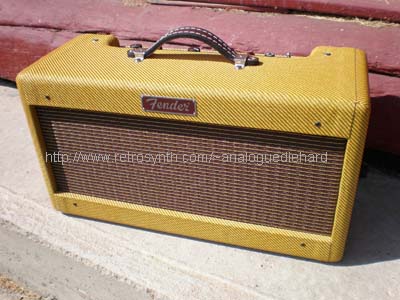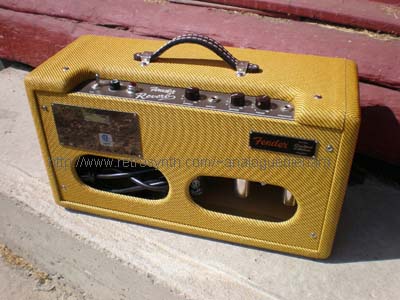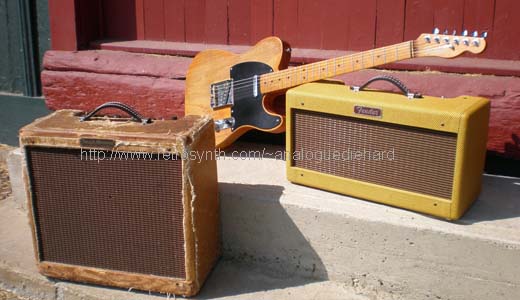Fender Reverb reissue "tweed" spring reverb
Last Update 07-08-2012
Ever have an amplifier that you wish had
spring reverb? That's what Fender thought back in 1961 when they
introduced the Fender Reverb, a standalone spring reverb unit. It
was designed to be used inline with your guitar. The vintage
units became sought after and Fender reissued it blond, tan, black
tolex, and... tweed?
Technically this isn't a "reissue" because Fender never introduced it
until after the tweed
era. This tweed covered version is a limited edition, made only
for a short time. I landed this from one of my favorite jaunts
for used gear (I know I neglect to name this favorite jaunt. I
like it that way. I will only say that it is located in a large
city a couple hours drive from where I live). Me and my brother
own a few amps that we "wish had spring reverb" (deja vu?) and this thing filled
that role nicely.
As for a reissue, Fender had to make some compromises. The
original used a 6K6 power tube that hasn't been made for decades.
So they substituted the more readily available 6V6 which is slightly
more powerful but can be scaled to behave in the original 6K6's
purpose. This tube is the driver for the spring reverb.
Vintage freaks often get their thongs twisted in a knot over deviations
like this and frankly the difference in sound is so subtle that it
isn't worth the trouble. That is according to a well renowned
tube design engineer/vintage amp fanatic who owns the vintage item and
put the 6K6 from his unit into a reissue... and it sounded the
same. And his ears are as discriminating as mine are.
I'm not one to split hairs - I like my full head of hair as it is.
Unbeknownst to me, this was a foreshadowing of my acquisition of a very
vintage item two months later - a 1958 Fender "tweed" Harvard
amp. These two in addition to my Telecaster make
an excellent combination, audible and visual. This was not at all
planned, but nonetheless interesting that they "fell into place".
The Harvard and Reverb are an interesting study of contrast of new vs
fossel - a fifty year difference in age.
Moving on the topic of this page, the Reverb has controls marked Dwell,
Mix, and Tone. Dwell controls the drive level to the reverb tank
- too low and you get more noise, too high and you drive the reverb
tank into clipping (be careful not to damage the tank transformers into
saturation). The Mix control should be obvious. Tone is not
unlike that of a guitar, where rolling it back reduces high
frequencies. I would had liked a control to roll off low
frequencies but this is a faithful reproduction of a classic item.
OK, it's not a multi-effects, the reverb is a fixed RT60 with fixed
diffusion, etc. It only does one thing, but does it very very
very well. And how many digital reverbs make a glorious noise
when you bang the reverb tank? Nyeh, nyeh!

Home






